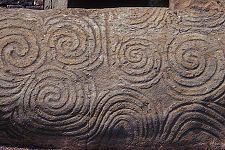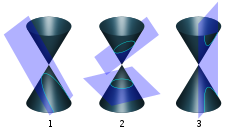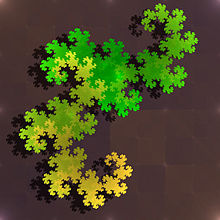
A | B | C | D | E | F | G | H | CH | I | J | K | L | M | N | O | P | Q | R | S | T | U | V | W | X | Y | Z | 0 | 1 | 2 | 3 | 4 | 5 | 6 | 7 | 8 | 9

In mathematics, a curve (also called a curved line in older texts) is an object similar to a line, but that does not have to be straight.
Intuitively, a curve may be thought of as the trace left by a moving point. This is the definition that appeared more than 2000 years ago in Euclid's Elements: "The line[a] is the first species of quantity, which has only one dimension, namely length, without any width nor depth, and is nothing else than the flow or run of the point which will leave from its imaginary moving some vestige in length, exempt of any width."[1]
This definition of a curve has been formalized in modern mathematics as: A curve is the image of an interval to a topological space by a continuous function. In some contexts, the function that defines the curve is called a parametrization, and the curve is a parametric curve. In this article, these curves are sometimes called topological curves to distinguish them from more constrained curves such as differentiable curves. This definition encompasses most curves that are studied in mathematics; notable exceptions are level curves (which are unions of curves and isolated points), and algebraic curves (see below). Level curves and algebraic curves are sometimes called implicit curves, since they are generally defined by implicit equations.
Nevertheless, the class of topological curves is very broad, and contains some curves that do not look as one may expect for a curve, or even cannot be drawn. This is the case of space-filling curves and fractal curves. For ensuring more regularity, the function that defines a curve is often supposed to be differentiable, and the curve is then said to be a differentiable curve.
A plane algebraic curve is the zero set of a polynomial in two indeterminates. More generally, an algebraic curve is the zero set of a finite set of polynomials, which satisfies the further condition of being an algebraic variety of dimension one. If the coefficients of the polynomials belong to a field k, the curve is said to be defined over k. In the common case of a real algebraic curve, where k is the field of real numbers, an algebraic curve is a finite union of topological curves. When complex zeros are considered, one has a complex algebraic curve, which, from the topological point of view, is not a curve, but a surface, and is often called a Riemann surface. Although not being curves in the common sense, algebraic curves defined over other fields have been widely studied. In particular, algebraic curves over a finite field are widely used in modern cryptography.
History

Interest in curves began long before they were the subject of mathematical study. This can be seen in numerous examples of their decorative use in art and on everyday objects dating back to prehistoric times.[2] Curves, or at least their graphical representations, are simple to create, for example with a stick on the sand on a beach.
Historically, the term line was used in place of the more modern term curve. Hence the terms straight line and right line were used to distinguish what are today called lines from curved lines. For example, in Book I of Euclid's Elements, a line is defined as a "breadthless length" (Def. 2), while a straight line is defined as "a line that lies evenly with the points on itself" (Def. 4). Euclid's idea of a line is perhaps clarified by the statement "The extremities of a line are points," (Def. 3).[3] Later commentators further classified lines according to various schemes. For example:[4]
- Composite lines (lines forming an angle)
- Incomposite lines
- Determinate (lines that do not extend indefinitely, such as the circle)
- Indeterminate (lines that extend indefinitely, such as the straight line and the parabola)

The Greek geometers had studied many other kinds of curves. One reason was their interest in solving geometrical problems that could not be solved using standard compass and straightedge construction. These curves include:
- The conic sections, studied in depth by Apollonius of Perga
- The cissoid of Diocles, studied by Diocles and used as a method to double the cube.[5]
- The conchoid of Nicomedes, studied by Nicomedes as a method to both double the cube and to trisect an angle.[6]
- The Archimedean spiral, studied by Archimedes as a method to trisect an angle and square the circle.[7]
- The spiric sections, sections of tori studied by Perseus as sections of cones had been studied by Apollonius.

A fundamental advance in the theory of curves was the introduction of analytic geometry by René Descartes in the seventeenth century. This enabled a curve to be described using an equation rather than an elaborate geometrical construction. This not only allowed new curves to be defined and studied, but it enabled a formal distinction to be made between algebraic curves that can be defined using polynomial equations, and transcendental curves that cannot. Previously, curves had been described as "geometrical" or "mechanical" according to how they were, or supposedly could be, generated.[2]
Conic sections were applied in astronomy by Kepler. Newton also worked on an early example in the calculus of variations. Solutions to variational problems, such as the brachistochrone and tautochrone questions, introduced properties of curves in new ways (in this case, the cycloid). The catenary gets its name as the solution to the problem of a hanging chain, the sort of question that became routinely accessible by means of differential calculus.
In the eighteenth century came the beginnings of the theory of plane algebraic curves, in general. Newton had studied the cubic curves, in the general description of the real points into 'ovals'. The statement of Bézout's theorem showed a number of aspects which were not directly accessible to the geometry of the time, to do with singular points and complex solutions.
Since the nineteenth century, curve theory is viewed as the special case of dimension one of the theory of manifolds and algebraic varieties. Nevertheless, many questions remain specific to curves, such as space-filling curves, Jordan curve theorem and Hilbert's sixteenth problem.
Topological curve
A topological curve can be specified by a continuous function from an interval I of the real numbers into a topological space X. Properly speaking, the curve is the image of However, in some contexts, itself is called a curve, especially when the image does not look like what is generally called a curve and does not characterize sufficiently
For example, the image of the Peano curve or, more generally, a space-filling curve completely fills a square, and therefore does not give any information on how is defined.
A curve is closed[b] or is a loop if and . A closed curve is thus the image of a continuous mapping of a circle. A non-closed curve may also be called an open curve.
If the domain of a topological curve is a closed and bounded interval , the curve is called a path, also known as topological arc (or just arc).
A curve is simple if it is the image of an interval or a circle by an injective continuous function. In other words, if a curve is defined by a continuous function with an interval as a domain, the curve is simple if and only if any two different points of the interval have different images, except, possibly, if the points are the endpoints of the interval. Intuitively, a simple curve is a curve that "does not cross itself and has no missing points" (a continuous non-self-intersecting curve).[8]
A plane curve is a curve for which is the Euclidean plane—these are the examples first encountered—or in some cases the projective plane. A space curve is a curve for which is at least three-dimensional; a skew curve is a space curve which lies in no plane. These definitions of plane, space and skew curves apply also to real algebraic curves, although the above definition of a curve does not apply (a real algebraic curve may be disconnected).

A plane simple closed curve is also called a Jordan curve. It is also defined as a non-self-intersecting continuous loop in the plane.[9] The Jordan curve theorem states that the set complement in a plane of a Jordan curve consists of two connected components (that is the curve divides the plane in two non-intersecting regions that are both connected). The bounded region inside a Jordan curve is known as Jordan domain.
The definition of a curve includes figures that can hardly be called curves in common usage. For example, the image of a curve can cover a square in the plane (space-filling curve), and a simple curve may have a positive area.[10] Fractal curves can have properties that are strange for the common sense. For example, a fractal curve can have a Hausdorff dimension bigger than one (see Koch snowflake) and even a positive area. An example is the dragon curve, which has many other unusual properties.
Differentiable curve
Roughly speaking a differentiable curve is a curve that is defined as being locally the image of an injective differentiable function from an interval I of the real numbers into a differentiable manifold X, often
More precisely, a differentiable curve is a subset C of X where every point of C has a neighborhood U such that is diffeomorphic to an interval of the real numbers.[clarification needed] In other words, a differentiable curve is a differentiable manifold of dimension one.
Differentiable arc
In Euclidean geometry, an arc (symbol: ⌒) is a connected subset of a differentiable curve.
Arcs of lines are called segments, rays, or lines, depending on how they are bounded.
A common curved example is an arc of a circle, called a circular arc.
In a sphere (or a spheroid), an arc of a great circle (or a great ellipse) is called a great arc.
Length of a curve
If is the -dimensional Euclidean space, and if is an injective and continuously differentiable function, then the length of is defined as the quantity
The length of a curve is independent of the parametrization .
In particular, the length of the graph of a continuously differentiable function defined on a closed interval is
which can be thought of intuitively as using the Pythagorean theorem at the infinitesimal scale continuously over the full length of the curve.[11]
More generally, if is a metric space with metric , then we can define the length of a curve by
where the supremum is taken over all and all partitions of .
A rectifiable curve is a curve with finite length. A curve is called natural (or unit-speed or parametrized by arc length) if for any such that , we have
Antropológia
Aplikované vedy
Bibliometria
Dejiny vedy
Encyklopédie
Filozofia vedy
Forenzné vedy
Humanitné vedy
Knižničná veda
Kryogenika
Kryptológia
Kulturológia
Literárna veda
Medzidisciplinárne oblasti
Metódy kvantitatívnej analýzy
Metavedy
Metodika
Text je dostupný za podmienok Creative
Commons Attribution/Share-Alike License 3.0 Unported; prípadne za ďalších
podmienok.
Podrobnejšie informácie nájdete na stránke Podmienky
použitia.
www.astronomia.sk | www.biologia.sk | www.botanika.sk | www.dejiny.sk | www.economy.sk | www.elektrotechnika.sk | www.estetika.sk | www.farmakologia.sk | www.filozofia.sk | Fyzika | www.futurologia.sk | www.genetika.sk | www.chemia.sk | www.lingvistika.sk | www.politologia.sk | www.psychologia.sk | www.sexuologia.sk | www.sociologia.sk | www.veda.sk I www.zoologia.sk























